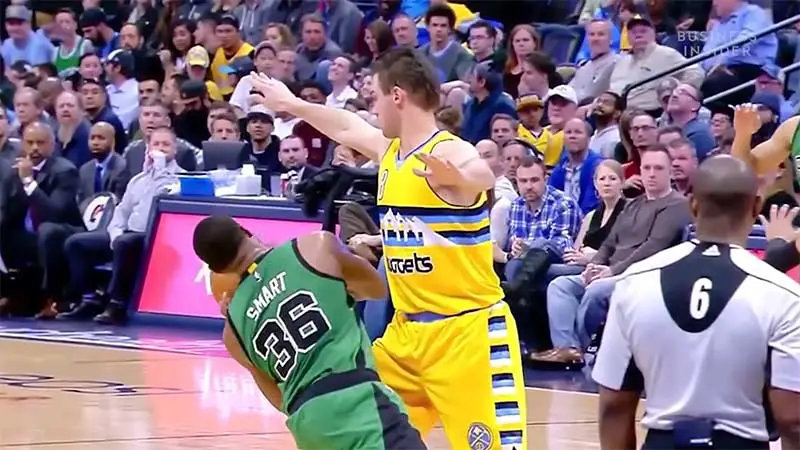In the high-paced world of basketball, players constantly push the boundaries to gain an edge over their opponents.
One controversial tactic that has sparked much debate is flopping—an intentional fall or stagger designed to deceive referees into calling a foul.
This act of “acting” not only disrupts the flow of the game but also undermines the integrity of the sport.
To combat this, the NBA introduced a rule in 1997, marking a 4-foot restricted arc near the basket to help officials identify and penalize flops.
By the 2012-13 season, the league took it a step further, imposing fines on players caught flopping. These measures aim to maintain fair play and ensure that skill, not theatrics, determines the outcome of the game.
Understanding the Flop in Basketball
Definition and Overview
In basketball, flopping involves exaggerating contact with an opponent to deceive referees into calling a foul, often through dramatic falls or staggers.
Although it’s offensive to game officials and criticized by Commissioner David Stern, consistent penalization is difficult.
It is not deemed unsportsmanlike, so in the NBA, flopping incurs a non-unsportsmanlike technical foul and one free throw for the opposing team without ejections.
Post-game reviews can lead to fines. FIBA follows similar rules, but the technical foul from flopping counts toward ejection.
The Impact on Game Dynamics
Flopping affects game dynamics by disrupting the natural flow of play. It leads to unwarranted fouls that can significantly affect game outcomes.
Players like Rasheed Wallace criticized flopping, arguing that it detracts from genuine defensive efforts.
In one instance, Wallace was fined $30,000 for his comments about Hedo Türkoğlu’s flopping, illustrating the tension surrounding this tactic.
The NBA has taken steps to mitigate the impact of flopping. Since the 2012-13 season, fines for post-game reviewed flops aimed to uphold fair play.
However, real-time identification remains challenging, limiting the effectiveness of these measures. Flopping’s exaggerated reactions, such as excessive flailing, complicate the referee’s task, making it a persistent issue despite ongoing efforts to address it.
Evolution of Flopping Rules
“Flopping” in sports, especially basketball and soccer, is when players deliberately fall or exaggerate contact to draw a foul from referees. The evolution of flopping rules aims to preserve the game’s integrity and promote fair play. This overview traces the development of these rules in basketball.
Early Practices and Original Rules
In the early years of basketball, there were no specific rules addressing flopping. Players like Bill Laimbeer and Dennis Rodman, known for their dramatic falls and reactions, exploited this gap to gain an advantage.
Their tactics introduced a controversial strategy, making it difficult for officials to distinguish legitimate fouls from exaggerated actions. Without a solid framework, referees relied heavily on their judgment to call fouls, often leading to inconsistent outcomes.
Recent Changes and Enforcement
To curb the growing issue of flopping, the NBA introduced fines during the 2012-13 season for players caught flopping in post-game video reviews, exemplified by a $5,000 fine against Chris Bosh.
In-game flopping detection remains challenging due to the game’s fast pace, leading to the use of technical fouls as a deterrent.
When Pacers Coach Frank Vogel criticized the Heat’s flopping, he was fined $15,000, showing the league’s intolerance for public criticism. Commissioner David Stern emphasized that flopping undermined officiating integrity.
The FIBA and NFHS adopted similar penalties to maintain consistency across basketball leagues. These measures highlight basketball authorities’ commitment to genuine defensive play and maintaining the sport’s integrity.
Famous Flops in NBA History
Flopping in the NBA has been a contentious issue, with several instances becoming iconic due to their sheer audacity or the consequences they had on the game. Here are some of the most famous flops in NBA history:
Notable Instances
Rašho Nesterović’s dramatic fall in a 2003 game stands out. After minimal contact, he exaggerated the impact, causing widespread discussions among fans and analysts. Rasheed Wallace also drew attention in 2009 with his claim that Hedo Türkoğlu duped officials into giving Wallace a technical foul by flopping.
Vlade Divac’s theatrics became synonymous with flopping in the late ’90s and early 2000s. His exaggerated reactions often drew ire from opponents. Manu Ginóbili added to the legacy with memorable flops that sparked debates about sportsmanship and rule enforcement.
Reactions and Controversies
Commissioner David Stern criticized flopping as offensive to officials, noting the NBA’s ongoing struggle to address it with fines and technical fouls. Despite efforts, identifying and penalizing flops in real-time remains difficult.
Stern emphasized the league’s commitment to game integrity. Coaches and players, like Rasheed Wallace, express frustration, with Wallace’s outburst against Türkoğlu resulting in a $25,000 fine for obscenities.
Critics argue flopping undermines competitiveness, calling for stricter enforcement and harsher penalties. Monty McCutchen, NBA’s senior VP of referee development, described flopping as involving secondary, excessive theatrical movements, aiming to reduce its occurrence and ensure fair play.
Preventative Measures and Future Prospects
To address the issue of flopping in sports, various leagues and governing bodies have implemented preventive measures and continue to explore future strategies. Here are some of the key measures and prospects for the future:
League Policies Against Flopping
The NBA has introduced policies to deter flopping to maintain the sport’s integrity, with fines for clear cases and suspensions for repeat offenders.
Although announced in 2008, real-time enforcement was initially slow. Officials started assessing non-unsportsmanlike technical fouls for flopping, allowing the opposing team one free throw.
Figures like Commissioner David Stern and player Rasheed Wallace have strongly opposed flopping for undermining fairness.
The Role of Technology in Detection
Technology’s role in detecting flopping has evolved as the NBA aims to enhance real-time identification. Video review systems allow officials to scrutinize suspected flops during games, though it’s challenging to make judgments solely from live-action views.
Advances in video analysis software provide opportunities to better identify flopping incidents. Technologies such as slow-motion replay and AI-driven analytics enable more accurate assessments, reducing human error.
Increased use of technology ensures officials uphold game integrity by minimizing flopping’s impact. Monty McCutchen emphasized education and training supported by technology to help referees consistently enforce anti-flopping rules.
Frequently Asked Questions
When did the NBA start fining for flopping?
The NBA introduced fines for flopping beginning in the 2012-13 season. This measure was implemented to deter players from using deceptive tactics and to maintain the integrity of the game.
Who were some early exploiters of flopping rules?
Players like Bill Laimbeer and Dennis Rodman were known for exploiting the lack of specific flopping rules early on in NBA history. Their tactics influenced the eventual introduction of anti-flopping regulations.
How does the NBA currently penalize flopping?
Currently, the NBA penalizes flopping with fines and technical fouls. Repeat offenders may face stricter penalties, such as suspensions. The goal is to discourage flopping and promote fair play.
Why is flopping considered harmful to basketball?
Flopping undermines the integrity of the game by rewarding dishonest behavior, which can sway the outcome of a match unfairly. It frustrates coaches, players, and fans who value genuine competition and fair officiating.
Conclusion
Flopping remains a contentious issue in basketball, challenging the integrity of the game. Despite measures like fines and technical fouls, real-time identification of flops is difficult.
The NBA’s ongoing efforts, including advanced video analysis and referee training, aim to curb this deceptive tactic.
The league’s commitment to fairness and genuine competition underscores the importance of addressing flopping effectively.
As technology evolves, the hope is that flopping will become less prevalent, ensuring a more honest and competitive atmosphere on the court.
Moreover, players and coaches must also take responsibility by promoting sportsmanship and integrity. As fans increasingly demand fair play, the collective effort to eliminate flopping will strengthen the game’s authenticity and viewer trust.








Buzz Williams